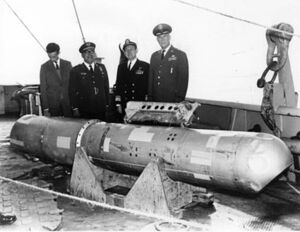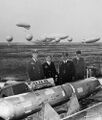1966 Palomares B-52 crash (nonfiction): Difference between revisions
(Created page with "thumb|The B28RI nuclear bomb, recovered from 2,850 feet (870 m) of water, on the deck of the USS Petrel.The '''1966 Palomares B-52 crash...") |
|||
| Line 6: | Line 6: | ||
<gallery mode="traditional"> | <gallery mode="traditional"> | ||
File:Palomares H-Bomb airships.jpg|Link=Carnivorous dirigible|Bomb recovered from Palomera generates flock of [[carnivorous dirigibles]]. | |||
</gallery> | </gallery> | ||
Revision as of 14:10, 17 December 2016
The 1966 Palomares B-52 crash, or the Palomares incident, occurred on 17 January 1966, when a B-52G bomber of the United States Air Force's Strategic Air Command collided with a KC-135 tanker during mid-air refuelling at 31,000 feet (9,450 m) over the Mediterranean Sea, off the coast of Spain. The KC-135 was completely destroyed when its fuel load ignited, killing all four crew members. The B-52G broke apart, killing three of the seven crew members aboard.
Of the four Mk28-type hydrogen bombs the B-52G carried, three were found on land near the small fishing village of Palomares in the municipality of Cuevas del Almanzora, Almería, Spain. The non-nuclear explosives in two of the weapons detonated upon impact with the ground, resulting in the contamination of a 2-square-kilometer (490-acre) (0.78 square mile) area by plutonium. The fourth, which fell into the Mediterranean Sea, was recovered intact after a 2½-month-long search.
In the News
Bomb recovered from Palomera generates flock of carnivorous dirigibles.
Fiction cross-reference
Nonfiction cross-reference
External links:
- 1966 Palomares B-52 crash @ Wikipedia

